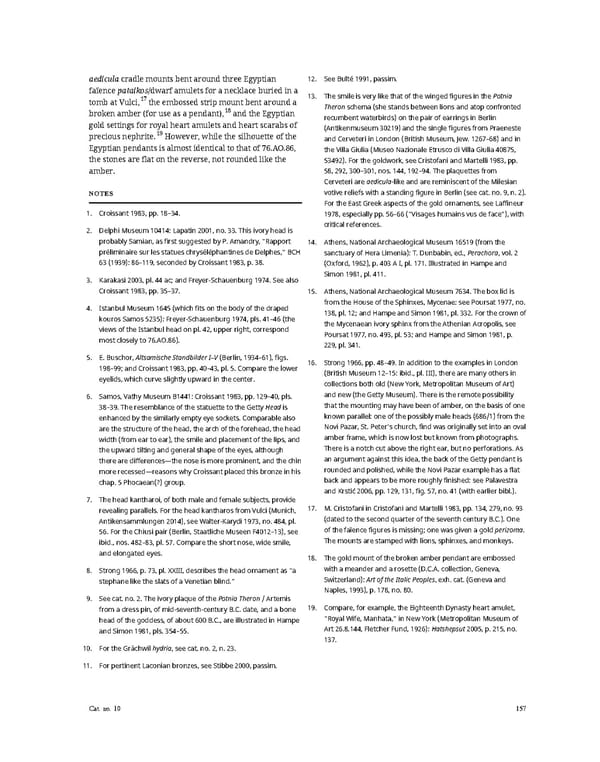aedicula cradle mounts bent around three Egyptian 12. SeeBulté 1991, passim. faïence pataikos/dwarf amulets for a necklace buried in a 13. The smile is very like that of the winged figures in the Potnia tomb at Vulci,17 the embossed strip mount bent around a broken amber (for use as a pendant),18 and the Egyptian Theronschema (she stands between lions and atop confronted gold settings for royal heart amulets and heart scarabs of recumbent waterbirds) on the pair of earrings in Berlin 19 (Antikenmuseum 30219) and the single figures from Praeneste precious nephrite. However, while the silhouette of the and Cerveteri in London (British Museum, Jew. 1267–68) and in Egyptian pendants is almost identical to that of 76.AO.86, the Villa Giulia (Museo Nazionale Etrusco di Villa Giulia 40875, the stones are flat on the reverse, not rounded like the 53492). For the goldwork, see Cristofani and Martelli 1983, pp. amber. 58, 292, 300–301, nos. 144, 192–94. The plaquettes from Cerveteri are aedicula-like and are reminiscent of the Milesian NOTES votive reliefs with a standing figure in Berlin (see cat. no. 9, n. 2). For the East Greek aspects of the gold ornaments, see Laffineur 1. Croissant 1983, pp. 18–34. 1978, especially pp. 56–66 (“Visages humains vus de face”), with 2. Delphi Museum 10414: Lapatin 2001, no. 33. This ivory head is critical references. probably Samian, as first suggested by P. Amandry, “Rapport 14. Athens, National Archaeological Museum 16519 (from the préliminaire sur les statues chryséléphantines de Delphes,” BCH sanctuary of Hera Limenia): T. Dunbabin, ed., Perachora, vol. 2 63 (1939): 86–119, seconded by Croissant 1983, p. 38. (Oxford, 1962), p. 403 A I, pl. 171. Illustrated in Hampe and 3. Karakasi 2003, pl. 44 ac; and Freyer-Schauenburg 1974. See also Simon 1981, pl. 411. Croissant 1983, pp. 35–37. 15. Athens, National Archaeological Museum 7634. The box lid is 4. Istanbul Museum 1645 (which fits on the body of the draped from the House of the Sphinxes, Mycenae: see Poursat 1977, no. kouros Samos 5235): Freyer-Schauenburg 1974, pls. 41–46 (the 138, pl. 12; and Hampe and Simon 1981, pl. 332. For the crown of views of the Istanbul head on pl. 42, upper right, correspond the Mycenaean ivory sphinx from the Athenian Acropolis, see most closely to 76.AO.86). Poursat 1977, no. 493, pl. 53; and Hampe and Simon 1981, p. 229, pl. 341. 5. E. Buschor, Altsamische Standbilder I–V (Berlin, 1934–61), figs. 16. Strong 1966, pp. 48–49. In addition to the examples in London 198–99; and Croissant 1983, pp. 40–43, pl. 5. Compare the lower (British Museum 12–15: ibid., pl. III), there are many others in eyelids, which curve slightly upward in the center. collections both old (New York, Metropolitan Museum of Art) 6. Samos, Vathy Museum B1441:Croissant 1983, pp. 129–40, pls. and new (the Getty Museum). There is the remote possibility 38–39. The resemblance of the statuette to the Getty Head is that the mounting may have been of amber, on the basis of one enhanced by the similarly empty eye sockets. Comparable also known parallel: one of the possibly male heads (686/1) from the are the structure of the head, the arch of the forehead, the head Novi Pazar, St. Peter’s church, find was originally set into an oval width (from ear to ear), the smile and placement of the lips, and amber frame, which is now lost but known from photographs. the upward tilting and general shape of the eyes, although There is a notch cut above the right ear, but no perforations. As there are differences—the nose is more prominent, and the chin an argument against this idea, the back of the Getty pendant is more recessed—reasons why Croissant placed this bronze in his rounded and polished, while the Novi Pazar example has a flat chap. 5 Phocaean(?) group. back and appears to be more roughly finished: see Palavestra and Krstić 2006, pp. 129, 131, fig. 57, no. 41 (with earlier bibl.). 7. The head kantharoi, of both male and female subjects, provide revealing parallels. For the head kantharos from Vulci (Munich, 17. M. Cristofani in Cristofani and Martelli 1983, pp. 134, 279, no. 93 Antikensammlungen 2014), see Walter-Karydi 1973, no. 484, pl. (dated to the second quarter of the seventh century B.C.). One 56. For the Chiusi pair (Berlin, Staatliche Museen F4012–13), see of the faïence figures is missing; one was given a gold perizoma. ibid., nos. 482–83, pl. 57. Compare the short nose, wide smile, The mounts are stamped with lions, sphinxes, and monkeys. and elongated eyes. 18. The gold mount of the broken amber pendant are embossed 8. Strong 1966, p. 73, pl. XXIII, describes the head ornament as “a with a meander and a rosette (D.C.A. collection, Geneva, stephane like the slats of a Venetian blind.” Switzerland): Art of the Italic Peoples, exh. cat. (Geneva and Naples, 1993), p. 178, no. 80. 9. See cat. no. 2. The ivory plaque of the Potnia Theron / Artemis from a dress pin, of mid-seventh-century B.C. date, and a bone 19. Compare, for example, the Eighteenth Dynasty heart amulet, head of the goddess, of about 600 B.C., are illustrated in Hampe “Royal Wife, Manhata,” in New York (Metropolitan Museum of and Simon 1981, pls. 354–55. Art 26.8.144, Fletcher Fund, 1926): Hatshepsut 2005, p. 215, no. 137. 10. For the Grächwil hydria, see cat. no. 2, n. 23. 11. For pertinent Laconian bronzes, see Stibbe 2000, passim. Cat. no. 10 157
 Ancient Carved Ambers in the J. Paul Getty Museum Page 166 Page 168
Ancient Carved Ambers in the J. Paul Getty Museum Page 166 Page 168